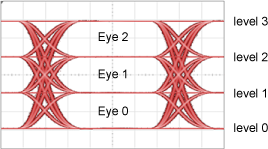5. Understanding Signal Parameters
In computer science the amount of information is measured in symbols (or bytes). Consequently, symbols/second units are used for the speed of information being transmitted. Digital communication codes information into physical properties. This coding is called modulation and packs one or multiple bits into symbols and then transmits each symbol separately. Therefore, the speed of transmission is called the symbol rate and measured in baud. Symbol rate is also referred to as signaling rate, modulation rate, or baud rate. The inverse of the symbol rate is called the Unit Interval (UI). One UI is the nominal time to transmit one symbol:

The traditional NRZ and RZ modulations code use one bit per symbol, and the baud rate happens to be the same number as the symbol rate. Consequently, people used baud and symbols/s interchangeable although technically they are not the same. More advanced modulation techniques code more than one bit into each symbol. For example, PAM4 codes two bits into each symbol. In such cases, the symbol rate is twice the baud rate:

Where Nvalues is the number of allowed physical values.
For example, a 25.78 Gbaud PAM4 signal transmits 51.56 Gbits/s. Each unit interval is 38.79 ps long and the nominal amplitude in the center is exactly one out of 4 possible choices. Some RF signals use complex modulations such as QAM-16. In this case each symbol contains one out of 16 possible complex values and the symbol rate is four times the baud rate.
| Signal Parameters | NRZ | PAM4 | ||||
|---|---|---|---|---|---|---|
| Example 1 | Example 2 | Example 3 | Example 1 | Example 2 | Example 3 | |
| Bits/Symbol | 1 | 1 | 1 | 2 | 2 | 2 |
| Signaling Rate | 25 GBd | 28 GBd | 56 GBd | 25 GBd | 28 GBd | 56 GBd |
| Unit Interval | 40 ps | 36 ps | 18 ps | 40 ps | 36 ps | 18 ps |
| Symbol Rate | 25 GBd | 28 GBd | 56 GBd | 50 GBd | 56 GBd | 112 GBd |
| Fundamental Frequency | 13 GHz | 14 GHz | 28 GHz | 13 GHz | 14 GHz | 28 GHz |
| 3rd Harmonic | 38 GHz | 42 GHz | 84 GHz | 38 GHz | 42 GHz | 84 GHz |

